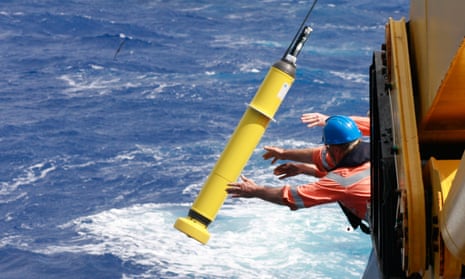Global warming has heated the oceans by the equivalent of one atomic bomb explosion per second for the past 150 years, according to analysis of new research.
More than 90% of the heat trapped by humanity’s greenhouse gas emissions has been absorbed by the seas, with just a few per cent heating the air, land and ice caps respectively. The vast amount of energy being added to the oceans drives sea-level rise and enables hurricanes and typhoons to become more intense.
Much of the heat has been stored in the ocean depths but measurements here only began in recent decades and existing estimates of the total heat the oceans have absorbed stretch back only to about 1950. The new work extends that back to 1871. Scientists have said that understanding past changes in ocean heat was critical for predicting the future impact of climate change.
A Guardian calculation found the average heating across that 150-year period was equivalent to about 1.5 Hiroshima-size atomic bombs per second. But the heating has accelerated over that time as carbon emissions have risen, and was now the equivalent of between three and six atomic bombs per second.
“I try not to make this type of calculation, simply because I find it worrisome,” said Prof Laure Zanna, at the University of Oxford, who led the new research. “We usually try to compare the heating to [human] energy use, to make it less scary.”
She added: “But obviously, we are putting a lot of excess energy into the climate system and a lot of that ends up in the ocean,. There is no doubt.” The total heat taken up by the oceans over the past 150 years was about 1,000 times the annual energy use of the entire global population.
The research has been published in the journal Proceedings of the National Academy of Sciences and combined measurements of the surface temperature of the ocean since 1871 with computer models of ocean circulation.
Prof Samar Khatiwala, also at the University of Oxford and part of the team, said: “Our approach is akin to ‘painting’ different bits of the ocean surface with dyes of different colours and monitoring how they spread into the interior over time. If we know what the sea surface temperature anomaly was in 1871 in the North Atlantic Ocean we can figure out how much it contributes to the warming in, say, the deep Indian Ocean in 2018.”
Rising sea level has been among the most dangerous long-term impacts of climate change, threatening billions of people living in coastal cities, and estimating future rises is vital in preparing defences. Some of the rise comes from the melting of land-bound ice in Greenland and elsewhere, but another major factor has been the physical expansion of water as it gets warmer.
However, the seas do not warm uniformly as ocean currents transport heat around the world. Reconstructing the amount of heat absorbed by the oceans over the past 150 years is important as it provides a baseline. In the Atlantic, for example, the team found that half the rise seen since 1971 at low and middle latitudes resulted from heat transported into the region by currents.
The new work would help researchers make better predictions of sea-level rise for different regions in the future. “Future changes in ocean transport could have severe consequences for regional sea-level rise and the risk of coastal flooding,” the researchers said. “Understanding ocean heat change and the role of circulation in shaping the patterns of warming remain key to predicting global and regional climate change and sea-level rise.”
Dana Nuccitelli, an environmental scientist who was not involved in the new research, said: “The ocean heating rate has increased as global warming has accelerated, and the value is somewhere between roughly three to six Hiroshima bombs per second in recent decades, depending on which dataset and which timeframe is used. This new study estimates the ocean heating rate at about three Hiroshima bombs per second for the period of 1990 to 2015, which is on the low end of other estimates.”










